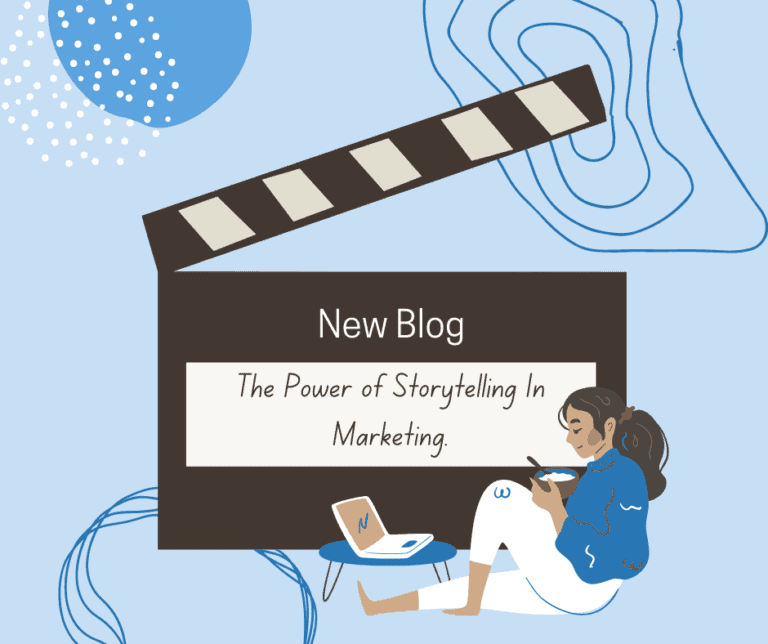The Power of Storytelling in Marketing
- By ramin
- June 24, 2021
- 4:22 pm

Everyone loves a good story — and that’s why implementing storytelling into your digital marketing endeavors is a great idea if you’re looking to engage your audience with content that really resonates, create a strong relationship between your consumers and your brand, and so much more.
But before we move on, we want to do a little exercise.
Give this video a watch:
Now this one:
If you were a consumer trying to do business with one of these brands, which messaging would you rather receive?
More likely than not, you’d rather hear a heartwarming story than an aggressive sale — the fostering of an emotional connection instead of just a pushy advertisement with a “buy one get one free” thrown in for good measure.
We’re not saying that strictly promotional content is dead. We’re saying that a better way to go about promoting your products and services is to use storytelling as a vehicle so you foster true human connections with your audience and make them customers for life.
Storytelling in Marketing: Why Does It Work So Well?
Incorporating storytelling in your marketing works particularly well because you’re employing the use of an emotional narrative to help push your messaging along, get people interested in what you have to offer, and create a strong community around your brand.
Just think about it like this: Nobody really gets too excited by a regular promotional advertisement, but ones that incorporate storytelling have a huge chance of going viral.
In fact, advertisements with purely emotional content perform twice as well as other types, and 70 percent of viewers who experienced an intense emotional response to an advertisement were more likely to buy the product. And what’s more is that people remember stories 22 times more than facts and figures alone — so you’re not only getting people interested in what you have to offer but you’re also making sure it sticks.
Still not convinced? Check out how the top brands are incorporating storytelling into their marketing.
How to Identify and Construct a Strong Brand Narrative
Every great story, at its essence, consists of a strong character, a plot, some conflict, and a resolution — and the same goes for storytelling in marketing.
For best results, you’ll need to find an awesome customer who’s connected to your brand on a deeper level, draw up some things that give context to the situation, incorporate some sort of pain point, challenge, or conflict, and finally, offer a solution that only your products or services can provide.
According to Simplicable, there are various types of storytelling in marketing:
- Mission: The reason why your business exists.
- Vision: Creating an intriguing portrayal of your company, brand, and products.
- Legacy: Sharing tales of your past as a company or brand.
- Founders & Employees: Who your people are and what makes them so great.
- Organizational Culture: Showcasing what it’s like to be part of your company.
- Personalities: Using an employee’s story to push your messaging along or creating a character within your brand to use as a vehicle for your story (re: like a mascot).
- Customers: Incorporating customer stories to show others why they should choose to do business with you.
- Events: Hosting an event and then telling the story behind it.
- Sustainability: Showcasing what your company does in terms of sustainability, charitable ongoings, community involvements, and more.
- Product: The story of your product with details about what makes it so special, including the ingredients, creation or manufacturing process, and more.
Whatever route you decide to take, remember that the most impactful stories are ones we can relate to. We’re not saying you need to make every tale a heart-wrenching Sarah Mclaughlin ad, but implementing emotion into your narrative is an absolute must.
And in order to find a great story, you may want to start by identifying common pain points your customers share and thinking about how your products and services alleviate those issues.
But keep in mind that storytelling is really about things like sharing useful information in a narrative, showcasing what motivates your team, and telling the tale of what your brand stands for — not your sales goals, an advertisement, or a pitch about why your company is so great.
For best results, keep it authentic, keep it emotionally intuitive, and keep it human.
Thanks for Reading!
Thanks for taking the time to read our blog!
If you’re ready to add the power of storytelling to your digital marketing belt but still aren’t sure how to get started, our eager team of skilled creatives here at OpticTour would love to lend a hand.
Whenever you’re ready, you can schedule your free marketing consultation by heading to this link.

© 2021 OpticTour. Trademarks and brands are the property
of their respective owners.
Google and the Google logo or any other related screenshots are registered trademarks of Google LLC, used with permission.
